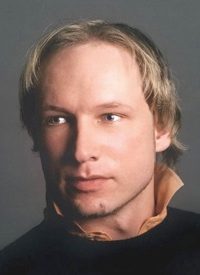
After a deluge of news reports pinning the Norway terror attacks on Muslim extremists — who originally took the credit and celebrated the tragedy — it emerged that the admitted perpetrator in police custody was in fact a 32-year-old native Norwegian named Anders Behring Breivik.
Suddenly, the narrative morphed. An early statement by police and a suspicious Facebook profile suggested the shooter was a “Christian,” a Freemason, and a “right-wing extremist” of some variety. Since then information has continued to surface — including a 1,500-page “manifesto” and a short video attributed to Breivik.
Large sections of the document he reportedly released, entitled “2083: A European Declaration of Independence,” have already been identified as plagiarized from the “Unabomber.” Terrorist Ted Kaczynski, following his involvement in psychological experiments linked to the Central Intelligence Agency, sent out letter bombs and various screeds against modern society.
Often contradictory, the massive manifesto released by Breivik features writings from his “diary,” quotes from a wide range of sources, insights into his beliefs and planning, historical information, and more. But the picture that emerges is far more complex than the simple-minded caricature of a “conservative Christian” being painted by much of the media. In fact, Breivik essentially admitted in his writing (not to mention his deeds) that he was not actually a Christian at all in the true sense.
Politics
Breivik regularly described himself as a “nationalist.” While the term means many things to different people, the terrorist understood it primarily as opposition to what he perceived as a takeover of European nations by immigrants — mostly from Islamic countries. The apparent obsession with national and cultural identity over the individual has led several prominent commentators to describe him as a “collectivist.”
While much of the world media has characterized Breivik as some sort of “neo-Nazi,” the comparison of the ideology espoused in the manifesto to the ideas of National Socialism is only partly accurate. It has indeed emerged recently that he was a member of certain online forums and groups associated with neo-Nazism. But in several important respects, the link to National Socialism is off the mark.
For one, he was generally critical of Hitler and racism. The manifesto also refers to Israel and Zionism hundreds of times — always in a positive light. “So let us fight together with Israel, with our Zionist brothers against all anti-Zionists,” he wrote. Norway, of course, has largely been perceived as hostile to Israel, particularly under the current ruling party that Breivik‘s terror was directed against.
In addition to Zionism, Breivik expressed strong support for the Indian Hindutva movement in the “war” against Islam. “India will continue to wither and die unless the Indian nationalists consolidate properly and strike to win,” he wrote. “It is essential that the European and Indian resistance movements learn from each other and cooperate as much as possible. Our goals are more or less identical.”
Prior to the rampage, Breivik had been active in mainstream Norwegian politics. Until 2004 he was involved with the Progress party, the second biggest in the nation’s parliament. But he later criticized them for adopting “political correctness” and “multiculturalism.”
Among the main subjects of hatred evidenced in the manifesto are native-born “traitors” who support multiculturalism and immigration. The attacks were apparently aimed at a very specific target: the Norwegian Labor Party. The initial blast in Oslo destroyed part of the Prime Minister’s office, while the rampage on the island targeted the party’s youth wing.
Breivik also praised the English Defence League (EDL), a British organization known for demonstrating against immigration and Islam, which he claimed to have assisted in the past. Recent news reports suggested that he did indeed have at least some contact with a few members, but the group issued a statement condemning violence and extremism.
Former British Prime Minister Winston Churchill is also mentioned on one version of a Facebook page attributed to Breivik. And Anglo-Saxon culture appears to have been a major influence in his writings — he signed the manifesto as “Andrew Berwick.”
Other points the rambling document dwells on include feminism and “cultural Marxism,” which he apparently saw as part of the broader attack on Western civilization by “elites.” Police have so far said they do not know whether his views motivated the attacks.
According to the document he released, one of the things that finally "tipped the scales" was the NATO bombing campaign in the former Yugoslavia. He apparently saw the international war effort as defending “Islamic imperialism” against Europeans who were fighting back against it.
Religion
One clear picture that emerges from available information is that Breivik was extraordinarily angry and worried about the “Islamization” of Europe and the West. Like many mainstream Westerners, he was upset over large-scale Muslim immigration and the perceived failure of “integration” policies.
While his writing does not indicate strong or genuine Christian religious beliefs, he appears to have viewed Christianity in terms of shared heritage and culture uniting the West. “Christianity is the ONLY cultural platform that can unite all Europeans, which will be needed in the coming period during the third expulsion of the Muslims,” he wrote.
More than four out of five Norwegians are technically members of the Lutheran-oriented state Church headed by the Norwegian King, but in practice very few Norwegians truly believe in Christianity. Breivik, though a member, was also critical: “Today's Protestant church is a joke. Priests in jeans who march for Palestine and churches that look like minimalist shopping centres,” he charged in an online post cited in media reports.
Breivik also denied that he had a relationship with Christ. “If you have a personal relationship with Jesus Christ and God then you are a religious Christian,” he added toward the end of the manifesto. “Myself and many more like me do not necessarily have a personal relationship with Jesus Christ and God. We do however believe in Christianity as a cultural, social, identity and moral platform. This makes us Christian.”
Much of the manifesto details past conflicts between Islam and Christianity. The date used in the title, 2083, refers to what will be the 400th anniversary of the Muslim defeat at the “Gates of Vienna.” The battle is seen by many as a critical historical juncture that was likely responsible for preventing the fall of Western Europe to the Ottoman Empire.
Breivik appears to have seen the “war” he thought he was waging in a similar light. In his manifesto, he claimed that he was involved in the formation of a group called the Knights Templar “to seize political and military control of western European countries and implement a cultural conservative political agenda.”
Despite Breivik’s claims about a new “Knights Templar,” this group has so far not been associated with the order by the same name within the upper echelons of Freemasonry today. Breivik described his “Knights Templar” as a secret group founded in 2002 at a meeting of activists in London, where he said atheists and agnostics were among those present.
According to historians, the original Knights Templar emerged around the 12th century. Their mission was to protect Christian pilgrims traveling to and from the Holy Land from Muslims. They eventually became extraordinarily wealthy and powerful.
By the 14th century, the Pope ordered that the group be disbanded. European monarchs participated in the attempt to squash the order, and many of its members were tortured and burned at the stake for charges ranging from Satan worship to pedophilia.
While historians disagree about what exactly happened next, it is sometimes theorized that at least a few Knights Templar were able to avoid capture. Fleeing to places such as Scotland, a small remnant of the order is said by some to have taken refuge in Masonic lodges.
The modern Knights Templar within the York Rite of Masonry addresses the issue on its website: “To simplify the story without attempting to elaborate or quote various researchers, all we know is that when Templary emerged in the early 1700's it was a part of Freemasonry,” the page states. “THERE IS NO PROOF OF DIRECT CONNECTION BETWEEN THE ANCIENT ORDER AND THE MODERN ORDER KNOWN TO DAY [sic] AS THE KNIGHTS TEMPLAR.”
Breivik was indeed involved in Freemasonry — one of the pictures he released showed him wearing a Masonic apron. But after his name was publicly cited in the press, he was immediately expelled from the fraternity. One of today’s Masonic Knights Templar groups also released a statement condemning the attack and saying it had nothing to do with the “Knights Templar” discussed in the terrorist manifesto.
Personality and Life
While there has been a great deal of controversy over the veracity of Breivik’s Facebook pages, the information on them has been widely cited in media reports. The profiles express an interest in violent computer games, classical music, and bloody movies and TV shows about vampires, serial killers, and more.
Before embarking on the murderous rampage, Breivik reportedly studied at the Oslo Commerce School. He also ran a farming business that, according to authorities, was a cover that allowed him to purchase large quantities of fertilizer used in bomb-making without arousing suspicion.
Details of his younger years are still being pieced together by journalists and investigators. It is known that Breivik was the son of a diplomat, as was Mumbai terror mastermind and former U.S. government asset David Coleman Headley. It has also been reported that he went to the same primary school as Norway’s crown Prince.
While some friends, family members, and media analysts have described him as mentally ill, he does not view himself in that way. In fact, he appears to have imagined himself as some sort of heroic character who would be embraced by large swaths of the population — eventually at least — as the “war” he anticipated between Muslims and Christians developed.
Of course, there are still countless questions about what really happened during the attack and what might have motivated Breivik. Witnesses and survivors from the island massacre have reported at least two shooters. Six unidentified suspects were also arrested by police in connection with the attack, but so far almost no information has been publicly released.
As more information becomes available, a clearer picture will probably start to emerge. But for now, it is obvious that simplistic media characterizations of the attacker have ranged from wildly inaccurate to outright deceptive.
Alex Newman writes from Sweden
Photo: Undated image obtained from the Twitter page of Anders Behring Breivik: AP Images


